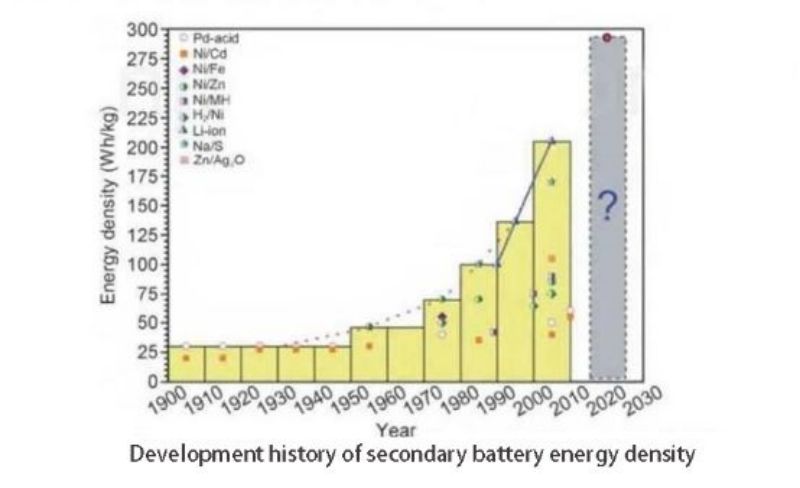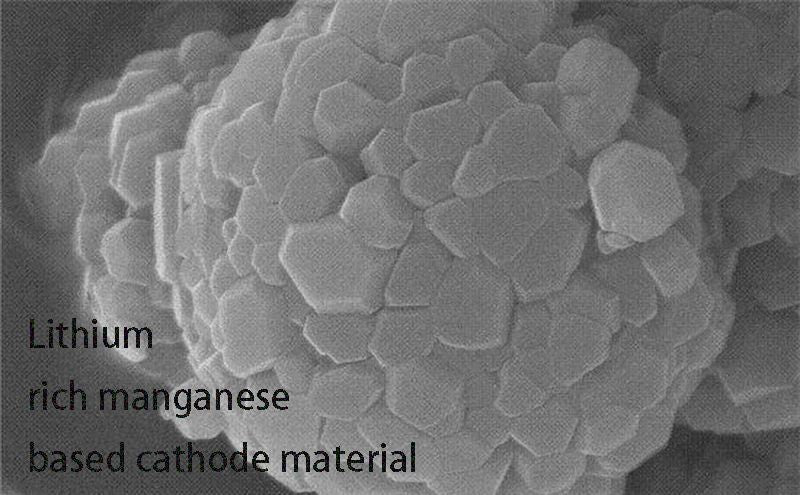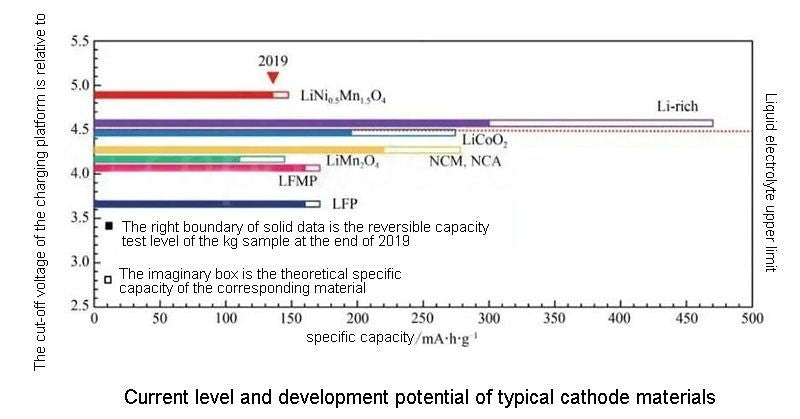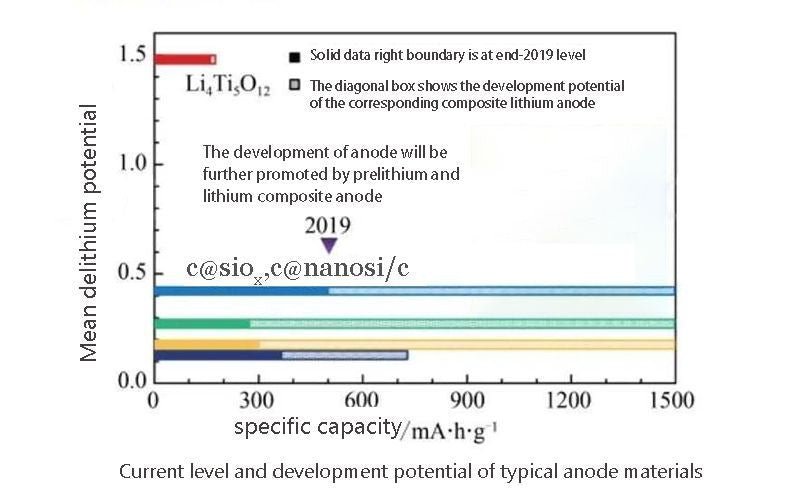
Main content:
- 1.Overview of high energy density lithium battery
- 2.Cathode materials for high energy density lithium batteries
- ①Lithium cobalt oxide cathode material
- ②Ternary cathode material
- ③Lithium rich manganese based cathode material
- ④Summary of cathode materials
- 3.Negative materials for high energy density lithium batteries
- ①Nano silicon based negative electrode material
- ②Nanocrystallization of silicon based materials
- ③Nano silicon carbon composites
- ④Nano silicon based negative electrode material
- ⑤Lithium metal negative electrode
- ⑥Construct three-dimensional carrier structure
- ⑦Design of artificial protective layer on surface
1.Overview of high energy density lithium battery
As the core component of electric vehicle, the energy density of power battery determines the one-time charging mileage of electric vehicle, but the problem of "mileage anxiety" has seriously affected the popularity of electric vehicle. Therefore, if you want to promote electric vehicles, you need to strive to improve the energy density of power batteries and use lithium ion battery high energy density to increase the cruising mileage.
Made in China 2025 has formulated a roadmap for the development of power batteries, requiring the energy density of single cells of power batteries in China to reach 300wh/kg in 2020, 400wh/kg in 2025 and 500wh/kg in 2030. However, these goals are far beyond the theoretical limits of traditional lithium-ion batteries. But lithium ion battery high energy density may be able to achieve it.
What determines the energy density?
Energy storage battery is a device that can realize the mutual conversion of chemical energy and electric energy. Its energy density refers to the energy that can be stored and released per unit battery mass or volume. Because the energy storage battery uses the oxidation-reduction reaction of materials to store energy and release energy, the theoretical limit of its energy density is determined by the active material with redox reaction, which depends on the number of electrons per unit active material can provide during the reaction and the redox voltage of the material.
When the material system of the battery is determined, the theoretical energy density of the battery has been determined. Only when a new material system appears can the leap of battery energy density be realized. The essence of increasing energy density is to increase the electric potential difference between positive and negative electrodes and the specific capacity of materials.

From the perspective of improving energy density, the negative electrode material for lithium ion battery high energy density has developed from graphite negative electrode material to Nano silicon carbon negative electrode, and lithium composite negative electrode material may appear in the future;
The cathode materials for lithium ion battery high energy density are mainly the further optimization and upgrading of the existing cathode materials of lithium cobalt oxide (LiCoO₂), ternary layered (NCM / NCA), lithium rich pickaxe base (Li-rich or 0L0), Lithium Manganate (LiMn204) and Nickel Lithium Manganate (LiNiO.5Mn1.5O4).
The selection of electrolyte, diaphragm and conductive additive materials needs to be considered based on the interface compatibility with the positive and negative materials and the performance of the materials themselves.
2.Cathode materials for high energy density lithium batteries
In order to further improve the energy density of lithium-ion batteries, manufacturing a lithium ion battery high energy density, cathode materials need to be considered from three aspects:
> develop cathode materials that can achieve high specific capacity at low potential, such as high nickel cathode materials;
> improve the lithium intercalation potential of the positive material to achieve higher capacity, such as high-voltage LCO, NCM and lithium rich manganese base oxide positive material;
> develop cathode materials with high working voltage, such as lithium nickel manganate Spinel Cathode (LNMO)
① Lithium cobalt oxide cathode material
Due to its high voltage platform and high compaction density, lico02 cathode material is still the mainstream cathode material in the 3C field with high requirements for bulk energy density. The application development from 4.48V to 4.5 to 4.6V still needs a lot of detailed work. At present, high quality surface coating is a feasible development path to match the protection of CEI on the cathode surface and the improvement of electrolyte stability.
② Ternary cathode material
NCM and NCA cathode materials with Ni content exceeding 0.80 have the advantages of high specific capacity and low cost, and the specific capacity will further increase with the increase of Ni content. However, the retention of Ni+ and Ni+ ions on the surface will be increased, resulting in the increase of Ni+ content and the stability of Ni+ residual oxidation. At present, the problems of high nickel NCM and NCA are mainly improved from the aspects of precursor process, sintering process, doping and coating.

High nickel cathode materials with Ni content around 0.8 have been commercialized. At present, most cathode material enterprises have mass produced NCM811 materials, including rongbai technology, Hunan Shanshan, dangsheng technology, Zhenhua new materials, etc., while beiteri and xiatungsten new energy have achieved mass production of NCA.
Products with higher nickel content are also under continuous research, development and improvement. The current development target is the reversible specific capacity of 210~230mA•h/g, which can be achieved by cathode materials above Ni90.
In order to improve stability, single crystal is a common technology developed by NCM. Developing high nickel layered oxides and low nickel high voltage layered oxides are two competitive technical routes at present.
③ Lithium rich manganese based cathode material
Lithium rich manganese based cathode materials have the advantages of high specific capacity, high working voltage, environmental friendliness and low cost. They are expected to become the preferred cathode materials for the next generation of high specific energy batteries.

Under the known lithium-ion battery material system, at present, only lithium rich manganese based cathode material combined with silicon carbon cathode is expected to make the energy density of lithium-ion battery cells reach more than 400W•h/kg.
Beijing Weilan New Energy Technology Co., Ltd. and the research team of the Institute of physics of the Chinese Academy of sciences have developed a monomer cell with a mass energy density greater than 500W·h/kg using lithium rich Mengji cathode material and ultra-thin metal lithium cathode. The volume energy density of the cell is close to 1200W·h/L and the cycle life can reach 100 cycles.
At present, lithium rich manganese based cathode materials are still in the research and development stage, and there is still a period of time before commercialization. For its key problems such as low coulomb efficiency, poor safety, poor cycle and rate performance in the first week, in-depth mechanism research is needed, and it is expected to be applied in lithium ion battery high energy density in batch in the future.
④ Summary of cathode materials
Lithium cobalt oxide (lCO), lithium nickel cobalt manganate (NCM), lithium nickel cobalt aluminate (NCA) and lithium rich manganese based (Li rich) cathode materials have relatively large room for improvement in specific capacity.
Among various cathode materials, lithium rich manganese based cathode materials can increase the energy density of lithium-ion battery monomer to more than 400w·h/kg, and its commercialization process is faster than that of lithium-free cathode materials. It is the most promising cathode material for the development of lithium ion battery high energy density in addition to high-voltage lithium cobalt oxide and high nickel cathode materials.

3.Negative materials for high energy density lithium batteries
At present, the specific capacity of commercial graphite anode is close to its theoretical maximum 372mA·h/g. if you want to further improve the energy density of the power battery. The development of new high-capacity cathode materials has always been another important research direction for the development of high specific energy lithium-ion batteries.
① Nano silicon based negative electrode material
Silicon is the cathode material with the highest theoretical specific capacity at present. Lithium forms LI4 in silicon At 4Si, the specific capacity of silicon is as high as 4200mA·h/g, which is much higher than the theoretical specific capacity of graphite negative electrode. The oxide SiOx (0 < x < 2) of silicon also has a high specific capacity (the theoretical specific capacity is greater than 2000mA·h/g). In addition, silicon-based negative electrode material also has the advantages of low lithium embedding potential, stable discharge level table and rich reserves, so it has become one of the most promising materials to replace graphite negative electrode.
The design of appropriate micro nano structure is very important for silicon-based negative electrode materials.
② Nanocrystallization of silicon based materials
The size of silicon-based particles directly affects whether it is powdered in the lithium process. The silicon-based negative electrode material can release stress faster in the nano dimension. Under the constraints of the surrounding medium, compared with the large-size silicon negative electrode, it is not easy to produce cracks, and effectively improves the rate energy and specific capacity of the silicon-based material.
The common methods of preparing nano silicon based particle materials include mechanical ball milling, sand grinding, chemical vapor deposition (CVD) and molten salt electrolysis.
③ Nano silicon carbon composites
Because nano silicon is easy to agglomerate, the volume changes greatly after lithium intercalation, and the local electronic conductivity and ionic conductivity change greatly after lithium intercalation, it is difficult to produce a stable SEI film on the silicon surface. The development of nano silicon carbon composites is the key to promote the application of silicon anode.
④ Nano silicon based negative electrode material
At present, nano silicon carbon composite negative electrode materials have begun to be commercialized, and some enterprises have realized the mass production of nano silicon carbon negative electrode materials with relatively low capacity.
Chinese enterprises that claim to be able to mass produce nano silicon-based negative electrodes include: beiteri, Tianmu pilot, zhengtuo energy, Shenzhen snow, Shanshan Co., Ltd., Jiangxi Zichen, etc;
International enterprises that can mass produce silicon-based negative electrodes are mainly concentrated in Japan and South Korea, and their representative companies include Hitachi chemical, Mitsubishi Chemical, Showa electric, shinyue, Wu Yu chemical, GS company of South Korea, etc.
⑤ Lithium metal negative electrode
Lithium metal is regarded as the ultimate material of lithium battery because of its theoretical capacity of 3860mA·h/g and the lowest reduction potential (relative to the standard hydrogen electrode -3.040v). However, while lithium metal anode brings high energy density, its disadvantages are also very obvious:
The high reactivity of lithium and the uneven deposition and stripping process during charge and discharge lead to serious pulverization and lithium dendrite growth in the cycle process, resulting in the rapid degradation of battery performance. Moreover, the growth of lithium dendrite will pierce the diaphragm, resulting in battery short circuit and serious safety accidents.
⑥ Construct three-dimensional carrier structure
At present, most of the current collectors are copper foil collectors, which is because copper has excellent conductivity, good mechanical properties and low price. However, these collectors are usually two-dimensional structure, which is difficult to solve the problems faced by metal lithium anode; It is an effective method to modify the collector to improve the uniformity of lithium metal deposition. Relevant studies show that the design of three-dimensional skeleton is expected to control the volume expansion in the process of metal lithium deposition, adjust the deposition behavior of metal lithium and inhibit the growth of lithium dendrites.
⑦ Design of artificial protective layer on surface
The SEI film generated by the reaction between metal lithium and electrolyte is a key factor affecting the performance of metal lithium negative electrode. Metal lithium negative electrode has quite high reaction activity, and it is difficult to generate uniform and dense SEI film when contacting with electrolyte. By designing artificial protective layer on the surface of metal lithium, it is possible to avoid the direct contact between metal lithium and electrolyte, avoid the consumption of active lithium by continuous side reactions, and design better mechanical properties SEI membrane with high ionic conductivity can significantly improve the performance of the battery.
At present, the large-scale commercial cathode materials are mainly graphite carbon materials and lithium titanate (LTO). With the gradual improvement of battery energy density, the traditional cathode materials are difficult to meet the demand of the next generation of lithium-ion batteries for high specific energy cathode. In the development direction of silicon-based negative electrode, researchers control the agglomeration of nano silicon through nano silicon carbon composite and inhibit side reactions, so as to inhibit the expansion of silicon-based negative electrode to a certain extent, improve its circularity and make it have a certain application scenario.

The technical route of high nickel ternary with nano silicon carbon anode has been widely recognized; With the gradual maturity of the preparation process of nano silicon carbon anode, nano silicon carbon anode with large room for improvement in specific energy is expected to be widely used.
Compared with nano silicon carbon negative electrode, composite metal lithium negative electrode has higher specific capacity and relatively easy control of volume expansion. Therefore, composite metal lithium negative electrode material is an ideal choice for lithium ion battery high energy density with energy density above 400W·h/kg.